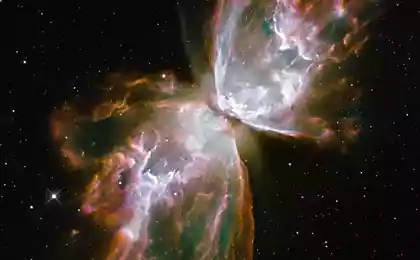1294
Tour of the space center
This Space Center Kennedy is located in the US state of Florida on Merritt Island, near Cape Canaveral. He is an active spaceport and the Mission Control Centre. Also, it built a special museum pavilions for tourists with a number of interesting things that we tell today the author.

The center is (of course) under the jurisdiction of the NASA, however, the travel part of it, there is entirely on the proceeds from sales of tickets, souvenirs, etc., Without using money from the budget. Therefore, despite the shatdaun government, currently the center is open to visitors:

Visit the Visitors Center, we started with a small covered pavilion entitled "Early space exploration." Its name speaks for itself:

Such was the room where the flight control is performed at the dawn of the space age. This is the room where the control was carried out during the mission "Mercury" - the first US manned space program and the first lunar program etam:

The suit of the "Mercury»:

Gemini spacesuit - the second stage of the lunar program. Astronaut is allowed while on the lunar surface

Notable progress - spacesuit used in the program "Apollo". This astronaut spacesuit protected from ultraviolet radiation, micrometeorites and withstands temperatures from -129 to 121 degrees Celsius:

Park missiles. There is 2 missiles used during the program Mercury - Redstone and Atlas, as well as missile launches first US satellite into space. All missiles were originally designed for military purposes and adapted for space exploration, in addition to the largest (the only one that is) - Apollo Saturn 1B - it has been designed from the ground up by NASA:

Here, in addition to missiles, there are various models of space capsules kotoryz you can sit in a posture in which there were astronauts. In this example, you need to "sit" by placing the back parallel to the ground, raising his feet and bending knees:


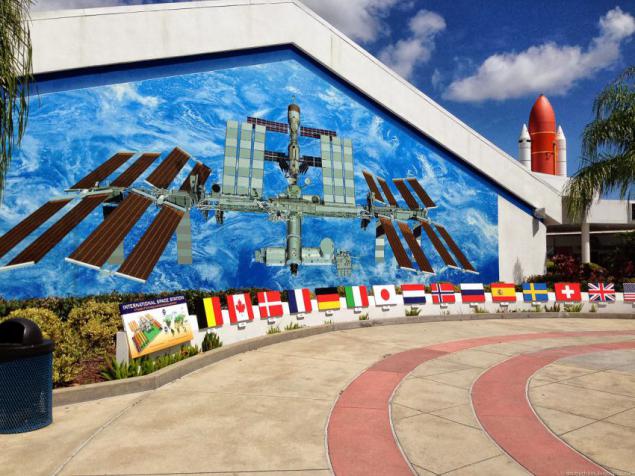

The main attraction of the Visitors Center - Space Shuttle Atlantis complex. Layout of additional fuel tank and booster rockets full size tour of the complex consists of several parts - the first is generally the big hall show a short film about the history of the shuttle program, then in a room smaller vaulted walls and projectors, projected image on the wall, show off Shuttle and what the astronauts see from its windows, then - the so-called self-tour of the main exhibition hall, and in the end - attraction "emulation of the Space Shuttle take off."

Shuttle hanging in the hall at the same angle at which it is in space, orbiting the earth
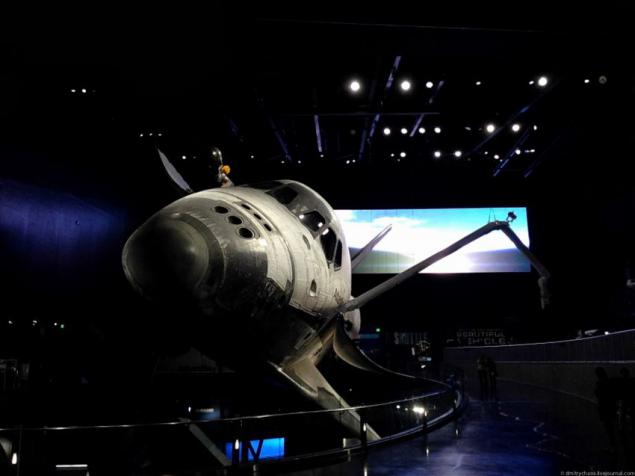
In organizing this exhibition has been spent over 100 million. Dollars:


Shuttle cab model:
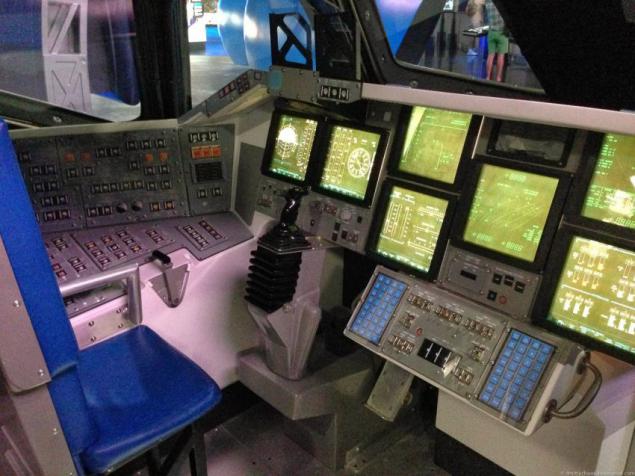

Toolkit astronaut:



The pavilion can crawl through the maze and transparent feel in the corridors of the space station:

And move out down the hill trajectory of the shuttle landing:
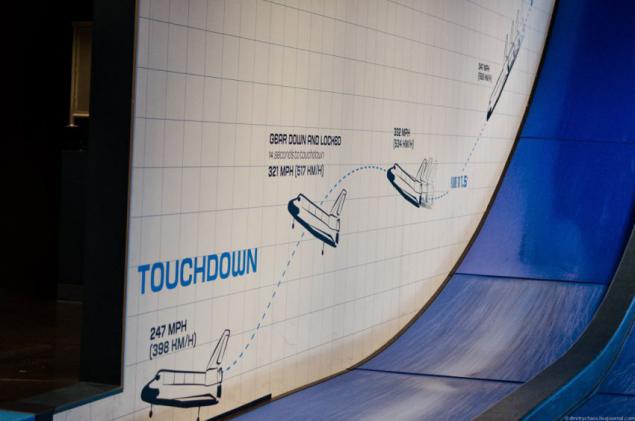
Layout:

Attraction Shuttle Launch Experience lets visitors feel (in my opinion, very roughly) that he feels an astronaut during a space shuttle launch. The room is directly in front of the main action, first describe the experience in words, on television shows interviews with real astronauts that describe this attraction as having the most natural effect of the start of all similar ones. Feeling of course interesting, but not as much as I expected - I was a little disappointed. Tour of the closed part of the complex is carried out on buses. We were only in the last round of this day - the time and cut down on the volume. All real objects we saw only from a distance, though the full tour you can go directly to the launch pad (need to go there again to get to the full tour). The building is on the horizon - Vehicle Assembly Building - a structure designed for the final assembly of spacecraft and launch vehicles before the start:

In the photo the building seems small, but in fact it is immense. Dimensions Assembly Building height - 160 meters, the length - 218 meters, width - 158 meters. The total volume of the building - 3,664,883 cubic meters occupied area - 3, 25 ha. The building is considered one of the biggest in the world. In it installed the world's highest gate, which goes to the opening 45 minutes. To present the scope of the guide brought some interesting "dimension" of the facts: for example, the area of the field of blue on the flag is equal to the square of the NBA basketball field, and the width of stripes on the flag is equal to the width of the bus:
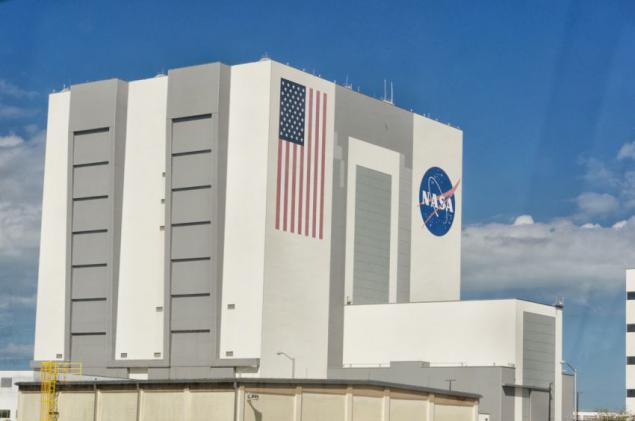
Due to a great height in the building sometimes formed clouds and precipitation. Admission is restricted to employees of NASA and the government. The size of all the Baikonur huge, but despite this, at the moment used only 9% of the entire territory of the complex. The remaining part is used as a wildlife sanctuary. That Americans are very proud, talking about the peaceful coexistence of science and space technologies and highest nature. In the center inhabited five thousand alligators, 330 species of birds, including bald eagles, 117 species of birds, 65 species of amphibians and 32 species of mammals.

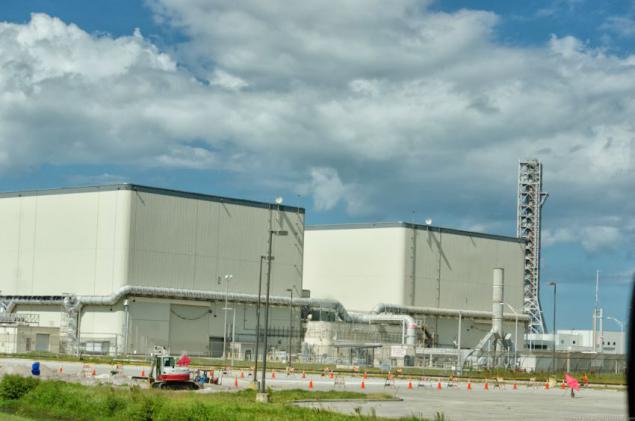
One of the launch pads:

These photos were taken from the place where the rostrum from which NASA officials, relatives and friends of the astronauts watch starts:

Since launching sites set up in July 2011 launched the space shuttle. They also came back here. The center has a landing strip for the shuttle long 4.6 km - one of the longest runways in the world. However, the first shuttle landing returning after their missions, at the Kennedy Center was not until February 11, 1984, when the "Challenger" completed the mission STS-41B; the first landing place until the time was Edwards Air Force Base in California. On the territory of the space center also has a pavilion dedicated to the Saturn-5 rocket and lunar program. Centre "Apollo-Saturn V» - a huge museum, built around the most valuable exhibits - reconstructed the starter "Saturn V» and other space-related exhibits, such as the capsule "Apollo."

Saturn rocket is huge:

Saturn assembled, installed on the launch pad consisted of more than 3.5 million parts. At the peak of the Apollo program assembly and preparation for the start of Saturn engaged 26,000 employees. Fully assembled Saturn with the lunar module at 18.3 meters higher than the Statue of Liberty on its pedestal:

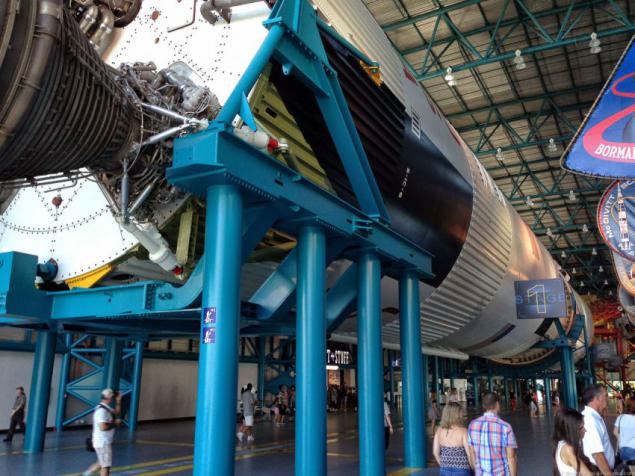

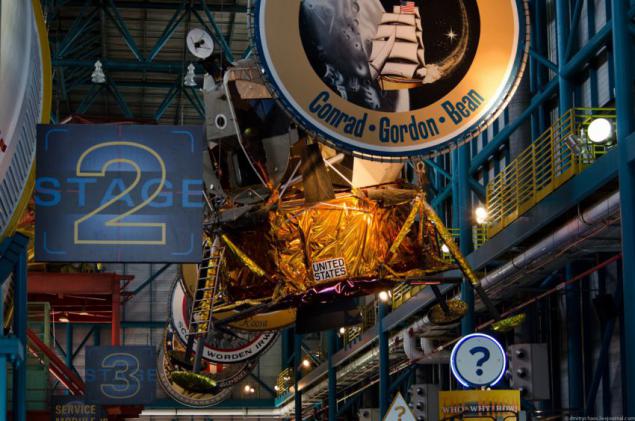

In the center of "Apollo - Saturn" is also a separate room - a treasure, which exhibited significant real artifacts related to the lunar program.

The capsule Apollo 14:

Several samples of lunar rocks:

The original suit Alan Shephard, who visited the moon during the Apollo 14 expedition. Covered with moondust:
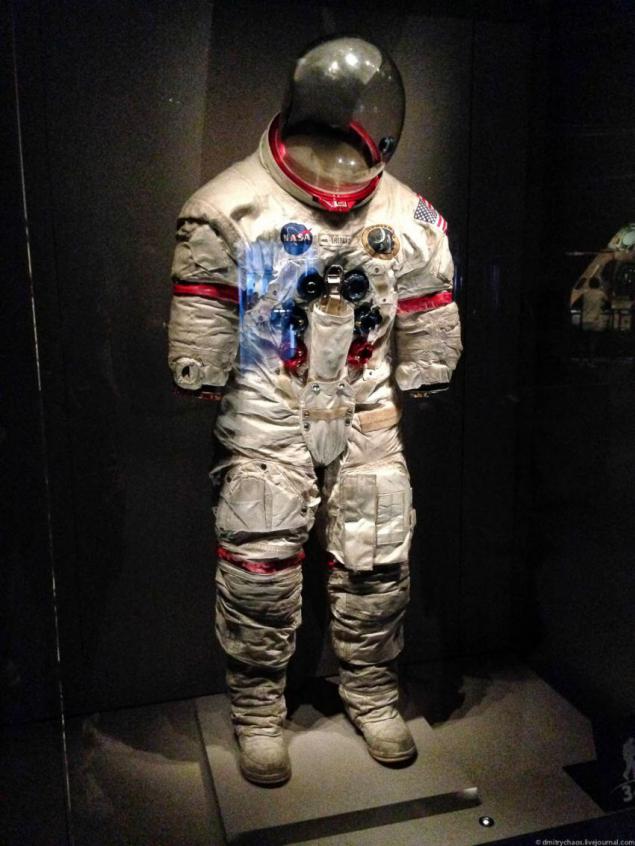

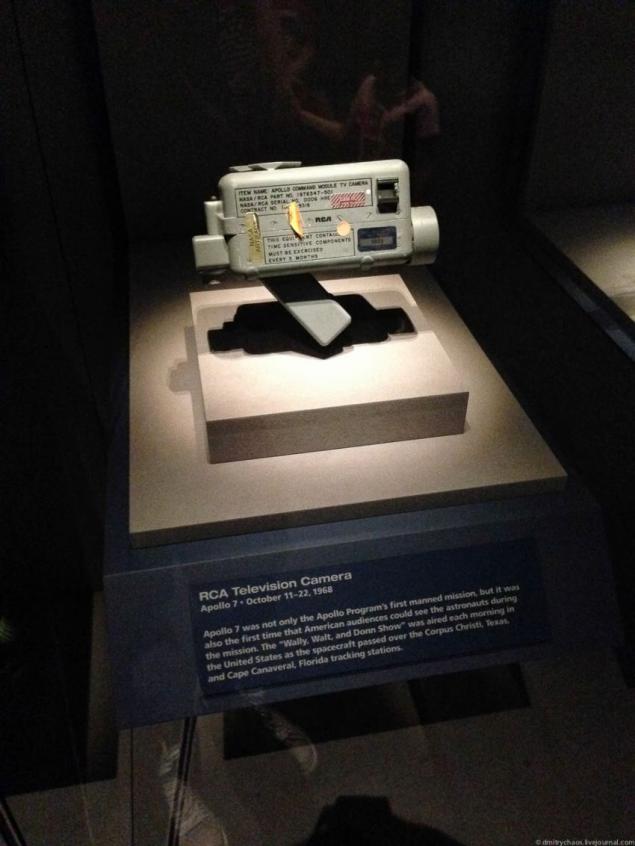
One piece of the Moon is available for visitors - you can touch it, put his hand through the uncomfortable gap in the armored glass:

This completes our tour of the space center John F. Kennedy. Finally, another interesting fact about the center: the territory on which the complex is located, accounts for more lightning strikes than any other place in the United States, forcing NASA to spend millions of dollars to prevent lightning strikes during startup.

Source: dmitrychaos.livejournal.com

The center is (of course) under the jurisdiction of the NASA, however, the travel part of it, there is entirely on the proceeds from sales of tickets, souvenirs, etc., Without using money from the budget. Therefore, despite the shatdaun government, currently the center is open to visitors:

Visit the Visitors Center, we started with a small covered pavilion entitled "Early space exploration." Its name speaks for itself:

Such was the room where the flight control is performed at the dawn of the space age. This is the room where the control was carried out during the mission "Mercury" - the first US manned space program and the first lunar program etam:

The suit of the "Mercury»:

Gemini spacesuit - the second stage of the lunar program. Astronaut is allowed while on the lunar surface

Notable progress - spacesuit used in the program "Apollo". This astronaut spacesuit protected from ultraviolet radiation, micrometeorites and withstands temperatures from -129 to 121 degrees Celsius:

Park missiles. There is 2 missiles used during the program Mercury - Redstone and Atlas, as well as missile launches first US satellite into space. All missiles were originally designed for military purposes and adapted for space exploration, in addition to the largest (the only one that is) - Apollo Saturn 1B - it has been designed from the ground up by NASA:

Here, in addition to missiles, there are various models of space capsules kotoryz you can sit in a posture in which there were astronauts. In this example, you need to "sit" by placing the back parallel to the ground, raising his feet and bending knees:




The main attraction of the Visitors Center - Space Shuttle Atlantis complex. Layout of additional fuel tank and booster rockets full size tour of the complex consists of several parts - the first is generally the big hall show a short film about the history of the shuttle program, then in a room smaller vaulted walls and projectors, projected image on the wall, show off Shuttle and what the astronauts see from its windows, then - the so-called self-tour of the main exhibition hall, and in the end - attraction "emulation of the Space Shuttle take off."

Shuttle hanging in the hall at the same angle at which it is in space, orbiting the earth

In organizing this exhibition has been spent over 100 million. Dollars:


Shuttle cab model:


Toolkit astronaut:



The pavilion can crawl through the maze and transparent feel in the corridors of the space station:

And move out down the hill trajectory of the shuttle landing:

Layout:

Attraction Shuttle Launch Experience lets visitors feel (in my opinion, very roughly) that he feels an astronaut during a space shuttle launch. The room is directly in front of the main action, first describe the experience in words, on television shows interviews with real astronauts that describe this attraction as having the most natural effect of the start of all similar ones. Feeling of course interesting, but not as much as I expected - I was a little disappointed. Tour of the closed part of the complex is carried out on buses. We were only in the last round of this day - the time and cut down on the volume. All real objects we saw only from a distance, though the full tour you can go directly to the launch pad (need to go there again to get to the full tour). The building is on the horizon - Vehicle Assembly Building - a structure designed for the final assembly of spacecraft and launch vehicles before the start:

In the photo the building seems small, but in fact it is immense. Dimensions Assembly Building height - 160 meters, the length - 218 meters, width - 158 meters. The total volume of the building - 3,664,883 cubic meters occupied area - 3, 25 ha. The building is considered one of the biggest in the world. In it installed the world's highest gate, which goes to the opening 45 minutes. To present the scope of the guide brought some interesting "dimension" of the facts: for example, the area of the field of blue on the flag is equal to the square of the NBA basketball field, and the width of stripes on the flag is equal to the width of the bus:

Due to a great height in the building sometimes formed clouds and precipitation. Admission is restricted to employees of NASA and the government. The size of all the Baikonur huge, but despite this, at the moment used only 9% of the entire territory of the complex. The remaining part is used as a wildlife sanctuary. That Americans are very proud, talking about the peaceful coexistence of science and space technologies and highest nature. In the center inhabited five thousand alligators, 330 species of birds, including bald eagles, 117 species of birds, 65 species of amphibians and 32 species of mammals.


One of the launch pads:

These photos were taken from the place where the rostrum from which NASA officials, relatives and friends of the astronauts watch starts:

Since launching sites set up in July 2011 launched the space shuttle. They also came back here. The center has a landing strip for the shuttle long 4.6 km - one of the longest runways in the world. However, the first shuttle landing returning after their missions, at the Kennedy Center was not until February 11, 1984, when the "Challenger" completed the mission STS-41B; the first landing place until the time was Edwards Air Force Base in California. On the territory of the space center also has a pavilion dedicated to the Saturn-5 rocket and lunar program. Centre "Apollo-Saturn V» - a huge museum, built around the most valuable exhibits - reconstructed the starter "Saturn V» and other space-related exhibits, such as the capsule "Apollo."

Saturn rocket is huge:

Saturn assembled, installed on the launch pad consisted of more than 3.5 million parts. At the peak of the Apollo program assembly and preparation for the start of Saturn engaged 26,000 employees. Fully assembled Saturn with the lunar module at 18.3 meters higher than the Statue of Liberty on its pedestal:





In the center of "Apollo - Saturn" is also a separate room - a treasure, which exhibited significant real artifacts related to the lunar program.

The capsule Apollo 14:

Several samples of lunar rocks:

The original suit Alan Shephard, who visited the moon during the Apollo 14 expedition. Covered with moondust:



One piece of the Moon is available for visitors - you can touch it, put his hand through the uncomfortable gap in the armored glass:

This completes our tour of the space center John F. Kennedy. Finally, another interesting fact about the center: the territory on which the complex is located, accounts for more lightning strikes than any other place in the United States, forcing NASA to spend millions of dollars to prevent lightning strikes during startup.

Source: dmitrychaos.livejournal.com



















